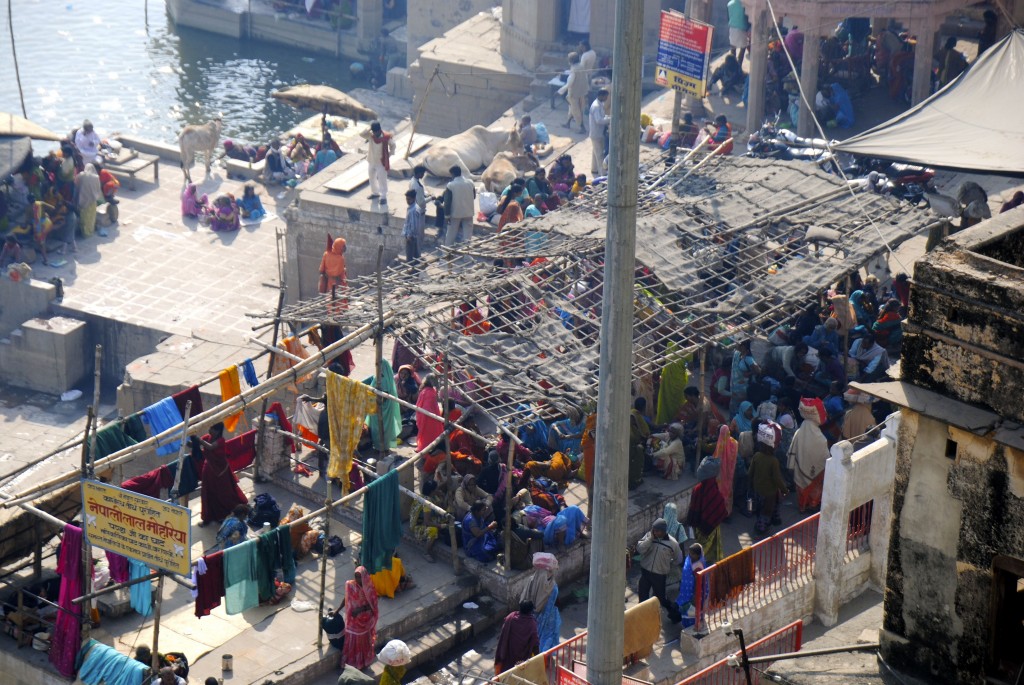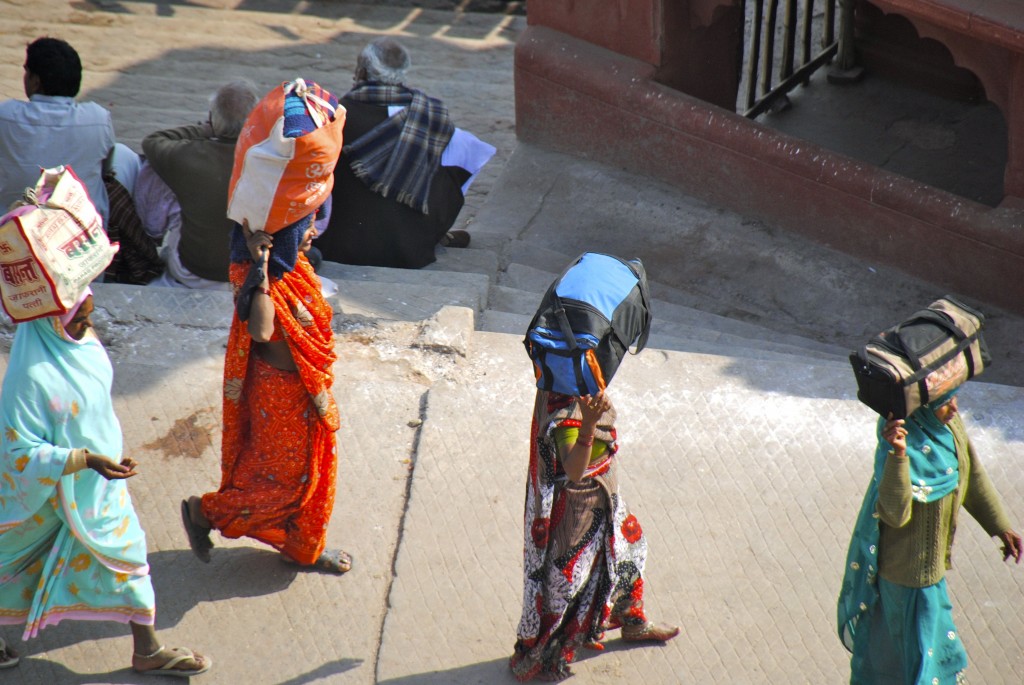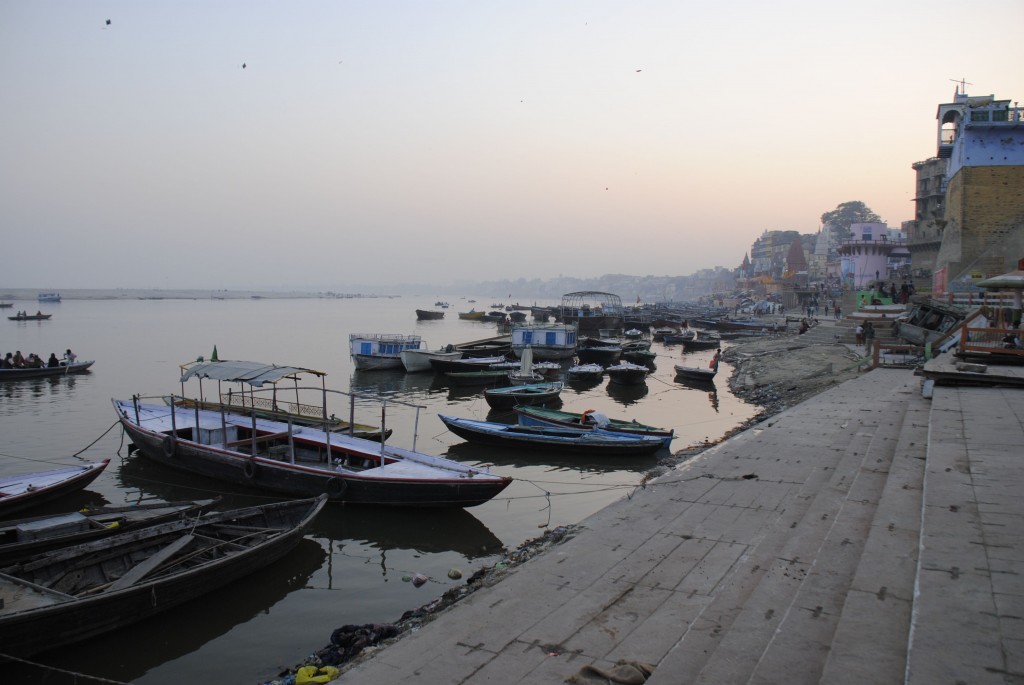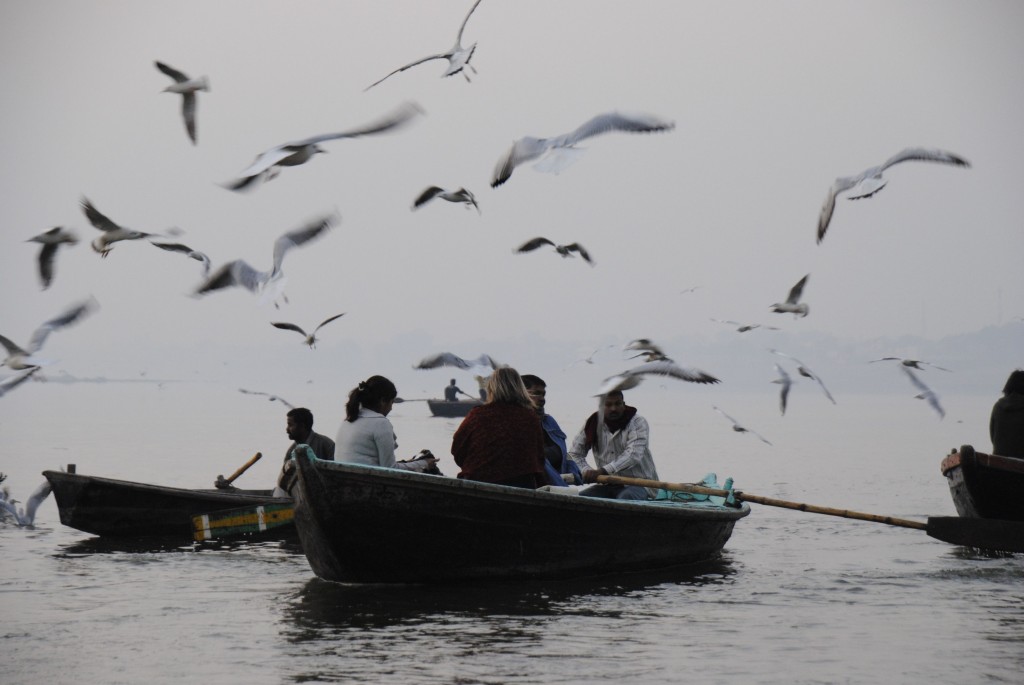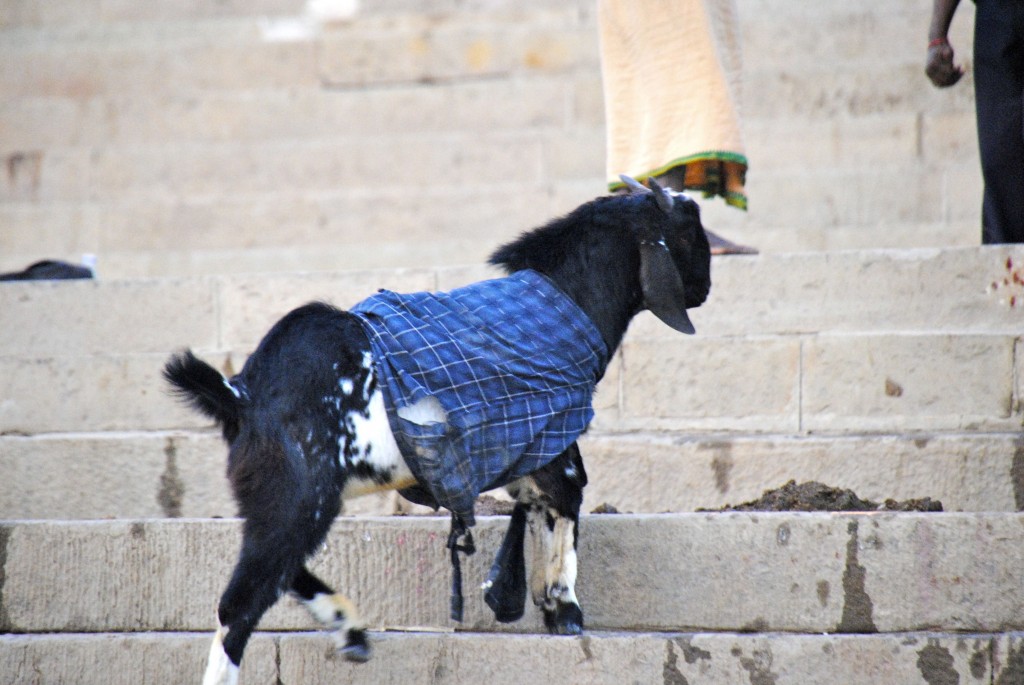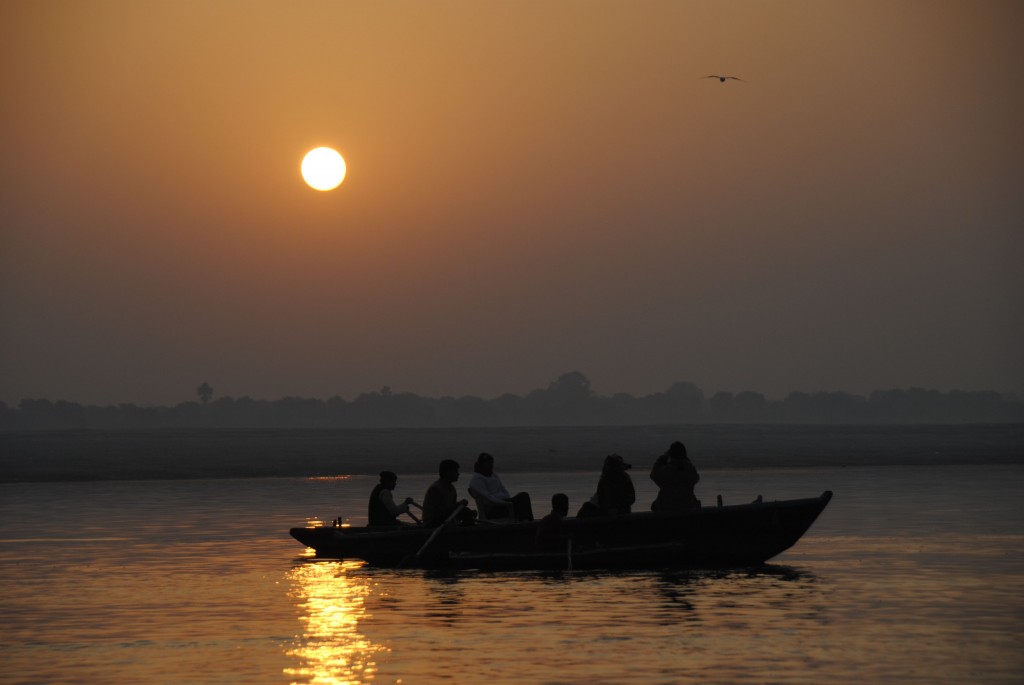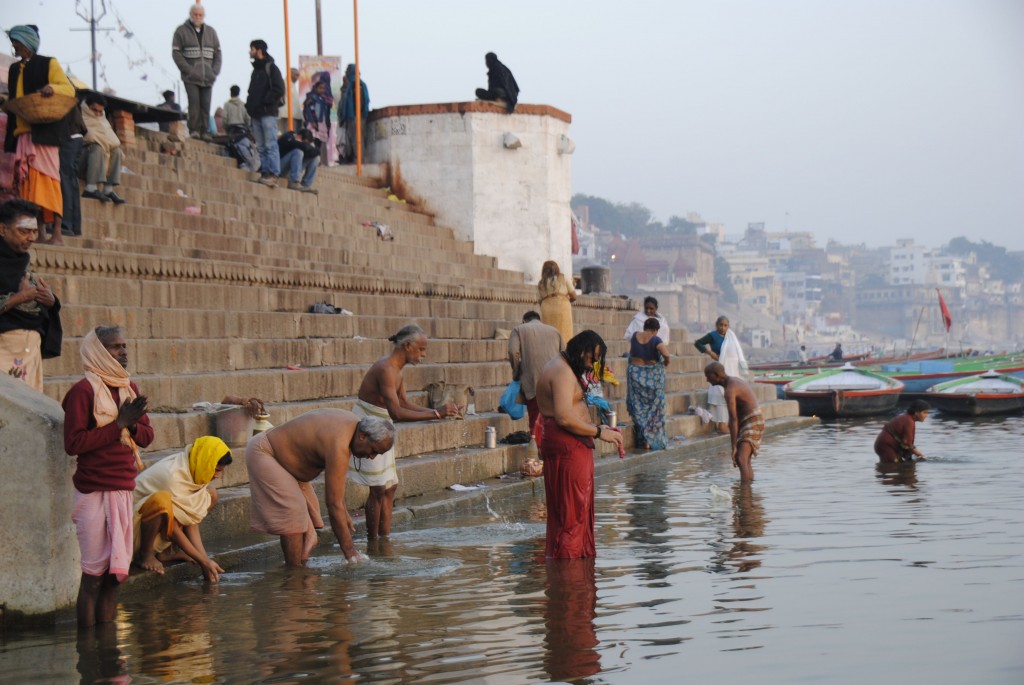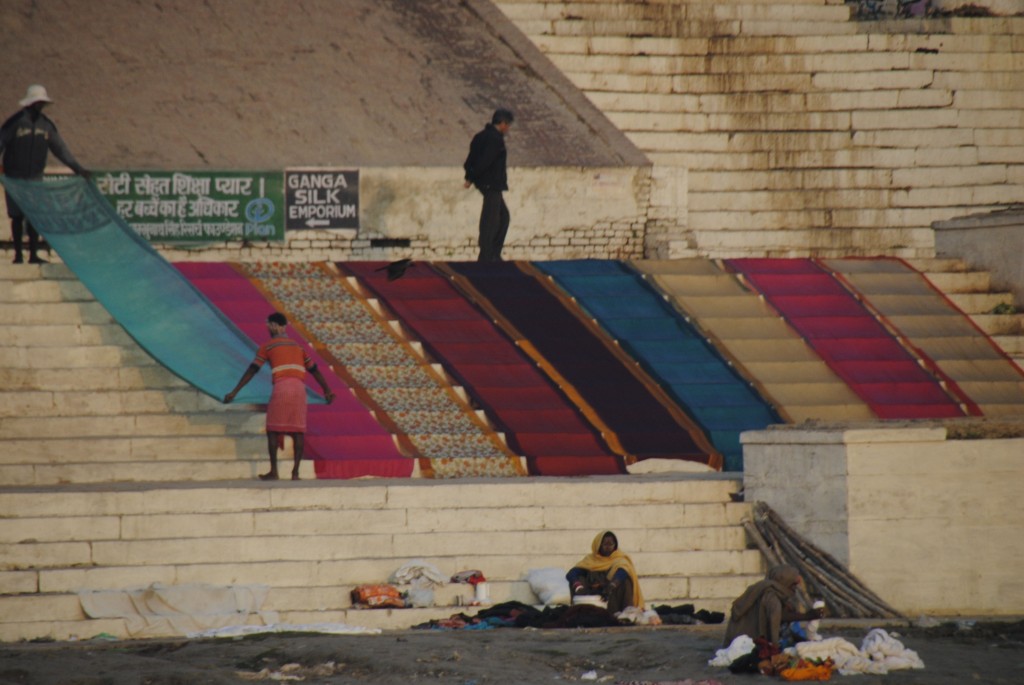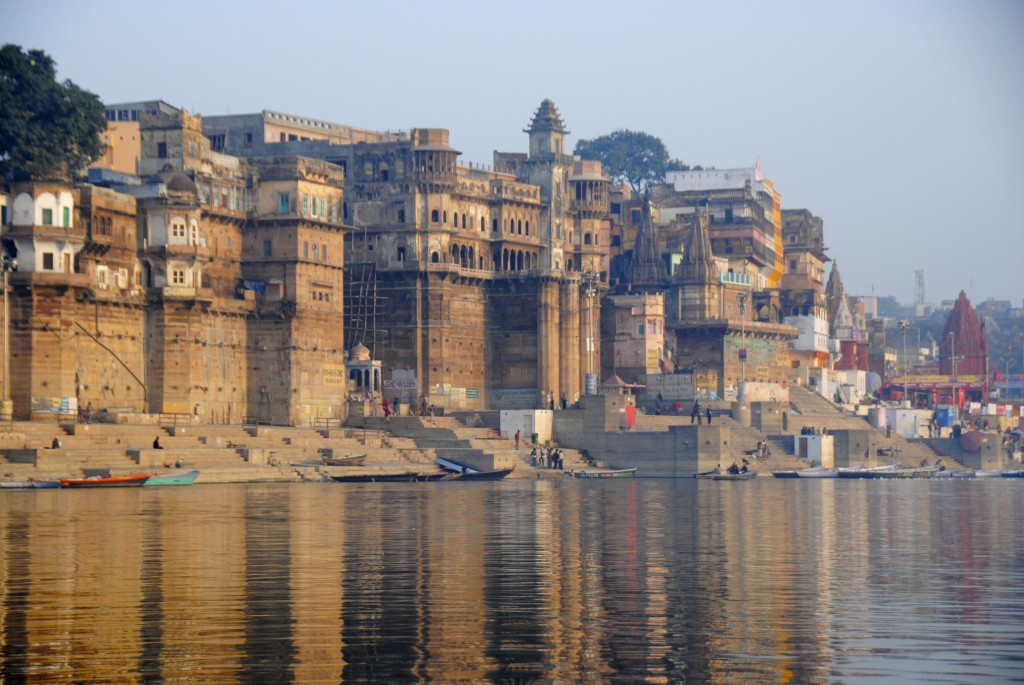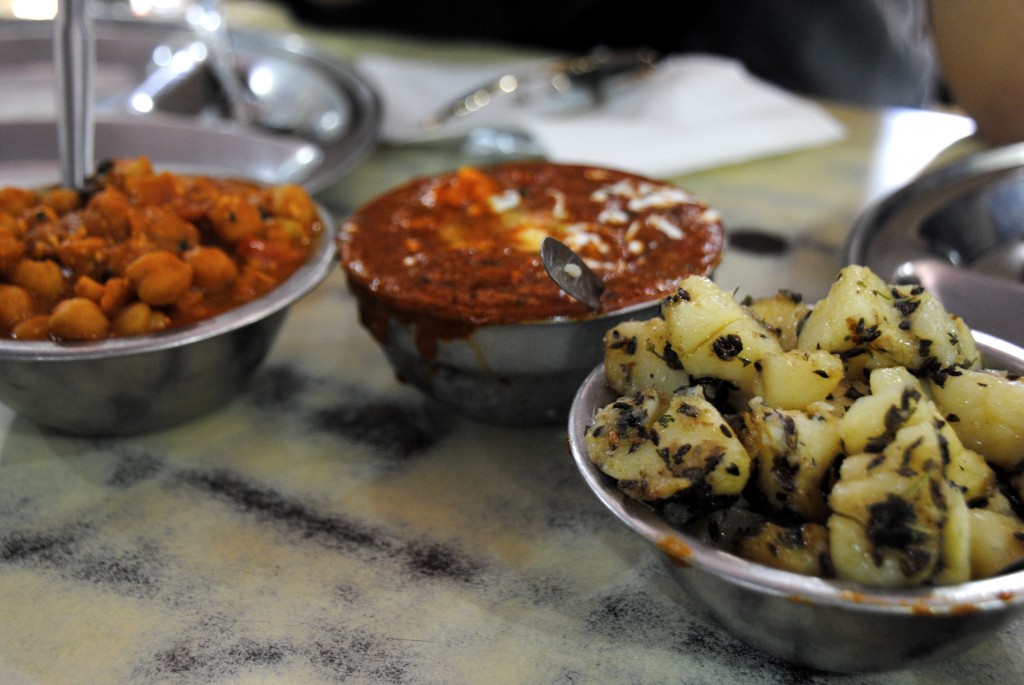December 21-22: Varanasi
Arrival in Varanasi will stick with me as one of the most vivid and powerful memories of India. Feeling “fresh” after a good night’s sleep curled up on the rocklike third bunk of the sleeper car, I stepped out to face a full-on assault of the senses and immediate immersion in Varanasi’s intensity: Straight ahead–a woman was kneeling to wash her laundry in the concrete sink on the train platform. She was wringing and beating her clothes, oblivious to the swarm of people surging past her, carrying children, suitcases, bags of rice, massive wrapped parcels. We forced our way through this crowd, past buckets of laundry, grizzled stray animals, and wafts of masala and urine. My eyes caught flashes of bright saris, and the indiscreetly staring eyes of Indian men. We followed the stream of people up some stairs to cross the tracks, getting pushed in every direction by people jostling to get ahead, who were nearly stepping on a disabled boy, literally crawling up the stairs. The mass of people parted around him only very slightly in the rush to move forward. Once we were able to exit the station we faced what looked like a battlefield–a concrete expanse strewn with prostrate bodies in various forms of discomfort, some sleeping, some gathered around fires, some arranging plastic bags over their feet. We were swarmed with rickshaw drivers jostling one another out of the way. “No, no, hotel pick-up,” we tried to say over their cries of “Cheap price for you!”
We safely found the hotel’s drivers, but the madness was only to continue on the road. At breakneck speed, our little autorickshaws careened through the most ridiculous traffic I’ve seen. My description will sound like an exaggeration, but in reality it doesn’t even come close to capturing the chaos. The lanes were mere suggestions, and accelerating into oncoming or stopped traffic was the norm. We entered what is best described as a cyclone of vehicles. Cars slammed on their brakes to miss cows, which ambled into the street, cutting off rickshaws, which swerved to avoid cyclists, who were coming dangerously close to pedestrians, who were trying to sell their prayer beads to passersby on motorbikes, who almost ran over stray dogs, that were magically sleeping unharmed in the middle of the road. Suddenly, our rickshaw stopped. Now we had to walk, because the streets were too narrow. We followed the driver through a maze of alleys, with no names, just elaborate signs painted on the walls pointing to hotels. The ground was covered in a slew of cow dung, paan spit, wastewater, and discarded food. Huge cows (and bulls) nibbled on trash bags, nearly blocking the alleys. Open storefronts sold chai, spices, jewelry, dyes, and yoga lessons. Finally the alleys opened up onto the ghats, giving us our first view of the holy Ganges River. While we were admiring the view we nearly got charged by a particularly territorial bull, and quickly continued on our way to our hotel. The Scindhia Guesthouse was an incredibly pleasant experience, offering much needed showers, and a nice view of life along the river below–although we were warned to keep this balcony door closed at all times to keep out the street monkeys, which we could see squabbling on nearby rooftops.
After we had rested enough to handle venturing back into the chaos below, we set out to explore the city. Varanasi is the holiest city in the world for Hindus, and its identity and daily life is closely tied to the holy Ganges River. Along the river are a series of ghats, steps leading to the water that form a central part of the city for tourists and residents alike. Despite the fact that it is a highly touristed city, life continues to go on, unsanitized and uncompromising, on the ghats. Closest to where we were staying was the “burning ghat,” the area where bodies are continuously cremated day and night. Because it is such a holy place, Varanasi is seen as an auspicious place to die and be cremated. Even as we were squeezing our way through the alleys, men carrying shrouded bodies passed by. Standing just above the burning ghats, the air was filled with floating ashes, which settled on spectators like snow, as bodies were set ablaze below, with the exact amount of wood necessary to burn entirely.
During our first night, we took a sunset walk along the ghats, enjoying watching people do yoga along the water, perform prayers and other ceremonies, and play cricket. Cows and goats (some wearing sweaters) ambled along beside us. We were constantly shooing overeager and pesky touts, who would not give us a moment’s peace from repeated offers of boat rides or tours or the best silk shop in town. Here more than anywhere else we went to, people would not take no for an answer, and would try to follow for a bit to bother you into taking their offer. During our second day, one boy inexplicably followed us for over 45 minutes through the labyrinthine alleys, at first to get us to come to his shop, then to try to get us to hire him for directions, then seemingly just to hassle us.
Most of our time in Varanasi was spent this way–avoiding salesmen, walking along the ghats and observing the endless parade of humanity, taking detours through the fragrant, overcrowded alleys. On our second morning, we participated in perhaps the most common tourist tradition in the town: a sunrise boat ride. We woke up while it was dark, and only had to walk a few meters along the ghats before numerous rowboat-owners offered us rides. We bundled up as best we could (if I haven’t mentioned it yet, northern India was chilly!), and set off for two hours to watch the Ganges wake up. To our right, people were slowly coming to the river for their daily rituals. Some were doing laundry, most were praying, and many were brushing their teeth and bathing in the very cold, very polluted, water. To our left, the sun epically peaked over the horizon, silhouetting the many boats making their way along.
That afternoon, we enjoyed both the best and the worst meal in India. We found an incredible, very local place, where everything on the menu cost around 25 rupees or less (that’s around $0.50) and ordered an overflowing smorgasbord of curries, chickpeas, potatoes, onions, spinach, naan… We were all dazed and stuffed when we left.
Fast-forward 4 hours.
I had been feeling queasy for a little while and was looking forward to getting on the sleeper train back to Delhi so I could relax and escape the bombardment. We got in the rickshaws to take us to the station, and I was feeling increasingly bad. We rocketed through the mayhem of the streets, with horns blasting (most Indian drivers use the horn as if to say simply “I am driving”), and our driver singing some off-key tune. Things were rapidly plummeting downhill. Acute nausea, foul smells, obnoxious noises, it was like some undiscovered circle of hell. Suddenly, there was no more waiting. “I think…I’m gonna be…” I couldn’t finish the sentence because I had to put a hand over my mouth, while Mark yelled at the driver to pull over, and I jumped out and spewed all over the sidewalk. Indian ladies looked out at my suffering of their nearby shops with only mild curiosity.
Once at the station, I thought the worst was over. Feeling mildly heroic for my roadside adventure, I boarded the train ready for a much-needed 12-hour rest. I laid down on the top bunk, but instead of drifting off to sleep, 20 minutes later I was trying to scramble down the ladder with one hand over my mouth and racing to the bathroom. Indian train bathrooms are not places you want to linger in, even in the best of times. Unfortunately, for the next 12 hours, I would have to become very, very familiar with them.






